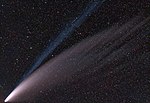Date of
closest
approach | Date
discovered | Object | Nominal geocentric distance [note 3] | Approx.
size (m) | (H)
(abs. mag.) | Closer
approach
to Moon [note 4] | References [4] [5] |
|---|
| (AU) | (Lunar
distance) |
|---|
| 2020-01-02 | 2020-01-04 | 2020 AP1 | 0.002185 AU (326,900 km; 203,100 mi) | 0.850 | 3.2–7.1 | 29.6 | ✓ | data · 2020 AP1 |
|
| 2020-01-20 | 2020-01-22 | 2020 BK3 | 0.001998 AU (298,900 km; 185,700 mi) | 0.778 | 11–25 | 26.9 | — | data · 2020 BK3 |
|
| 2020-01-22 | 2020-01-23 | 2020 BB5 | 0.001775 AU (265,500 km; 165,000 mi) | 0.691 | 3.1–6.8 | 29.7 | — | data · 2020 BB5 |
|
| 2020-01-25 | 2020-01-24 | 2020 BH6 | 0.000469 AU (70,200 km; 43,600 mi) | 0.183 | 5.1–11 | 28.6 | — | data · 2020 BH6 |
|
| 2020-01-27 | 2020-01-28 | 2020 BA13 | 0.001321 AU (197,600 km; 122,800 mi) | 0.514 | 4.4–9.9 | 28.9 | — | data · 2020 BA13 |
|
| 2020-01-28 | 2020-01-30 | 2020 BA15 | 0.002517 AU (376,500 km; 234,000 mi) | 0.980 | 8.8–20 | 27.4 | ✓ | data · 2020 BA15 |
|
| 2020-01-29 | 2020-01-28 | 2020 BZ13 | 0.000716 AU (107,100 km; 66,600 mi) | 0.279 | 2.8–6.2 | 29.9 | — | data · 2020 BZ13 |
|
| 2020-01-31 | 2020-02-02 | 2020 CZ | 0.002105 AU (314,900 km; 195,700 mi) | 0.819 | 3.5–7.8 | 29.4 | — | data · 2020 CZ |
|
| 2020-01-31 | 2020-02-02 | 2020 CJ | 0.002363 AU (353,500 km; 219,700 mi) | 0.919 | 11–25 | 26.9 | ✓ | data · 2020 CJ |
|
| 2020-02-01 | 2020-02-01 | 2020 CW | 0.000105 AU (15,700 km; 9,800 mi) | 0.041 | 0.82–1.8 | 32.6 | — | data · 2020 CW |
|
| 2020-02-02 | 2020-02-01 | 2020 CA | 0.001466 AU (219,300 km; 136,300 mi) | 0.570 | 3.2–7.1 | 29.6 | — | data · 2020 CA |
|
| 2020-02-03 | 2020-01-31 | 2020 BT14 | 0.001255 AU (187,700 km; 116,700 mi) | 0.489 | 7.7–17 | 27.7 | — | data · 2020 BT14 |
|
| 2020-02-04 | 2020-02-05 | 2020 CQ1 | 0.000431 AU (64,500 km; 40,100 mi) | 0.168 | 4.5–10 | 28.9 | — | data · 2020 CQ1 |
|
| 2020-02-13 | 2020-02-16 | 2020 DU | 0.002172 AU (324,900 km; 201,900 mi) | 0.845 | 4.8–11 | 28.7 | ✓ | data · 2020 DU |
|
| 2020-02-13 | 2020-02-15 | 2020 CD3 | 0.000315 AU (47,100 km; 29,300 mi) | 0.122 | 1.2–2.7 | 31.7 | — | data · 2020 CD3 |
|
| 2020-02-14 | 2020-02-15 | 2020 CQ2 | 0.000990 AU (148,100 km; 92,000 mi) | 0.385 | 5.1–11 | 28.6 | — | data · 2020 CQ2 |
|
| 2020-02-17 | 2020-02-17 | 2020 DP14 | 0.000803 AU (120,100 km; 74,600 mi) | 0.312 | 2.3–5.2 | 30.3 | — | data · 2020 DP14 |
|
| 2020-02-18 | 2020-02-17 | 2020 DA1 | 0.001294 AU (193,600 km; 120,300 mi) | 0.503 | 2.9–6.5 | 29.8 | — | data · 2020 DA1 |
| 2020-02-18 | 2020-02-16 | 2020 DW | 0.001612 AU (241,200 km; 149,800 mi) | 0.628 | 2.2–4.9 | 30.4 | — | data · 2020 DW |
|
| 2020-02-25 | 2020-02-27 | 2020 DR4 | 0.000622 AU (93,000 km; 57,800 mi) | 0.242 | 3.0–6.7 | 29.8 | — | data · 2020 DR4 |
|
| 2020-03-14 | 2020-03-17 | 2020 FD2 | 0.002190 AU (327,600 km; 203,600 mi) | 0.852 | 19–43 | 25.7 | — | data · 2020 FD2 |
|
| 2020-03-18 | 2020-03-16 | 2020 FD | 0.001714 AU (256,400 km; 159,300 mi) | 0.667 | 7.8–17 | 27.7 | ✓ | data · 2020 FD |
|
| 2020-03-19 | 2020-03-23 | 2020 FG4 | 0.001262 AU (188,800 km; 117,300 mi) | 0.491 | 11–25 | 26.9 | — | data · 2020 FG4 |
|
| 2020-03-22 | 2020-03-19 | 2020 FL2 | 0.000987 AU (147,700 km; 91,700 mi) | 0.384 | 16–36 | 26.1 | — | data · 2020 FL2 |
|
| 2020-03-25 | 2020-03-24 | 2020 FJ4 | 0.001716 AU (256,700 km; 159,500 mi) | 0.668 | 3.3–7.5 | 29.5 | — | data · 2020 FJ4 |
|
| 2020-03-31 | 2020-03-31 | 2020 FB7 | 0.000521 AU (77,900 km; 48,400 mi) | 0.203 | 16–36 | 26.1 | — | data · 2020 FB7 |
|
| 2020-04-01 | 2020-04-02 | 2020 GO1 | 0.000461 AU (69,000 km; 42,900 mi) | 0.180 | 8.0–18 | 27.6 | — | data · 2020 GO1 |
|
| 2020-04-03 | 2020-04-02 | 2020 GH | 0.000837 AU (125,200 km; 77,800 mi) | 0.326 | 4.2–9.4 | 29.0 | — | data · 2020 GH |
|
| 2020-04-05 | 2020-04-05 | 2020 GY1 | 0.000537 AU (80,300 km; 49,900 mi) | 0.209 | 13–28 | 26.6 | — | data · 2020 GY1 |
|
| 2020-04-15 | 2020-04-16 | 2020 HO | 0.001929 AU (288,600 km; 179,300 mi) | 0.751 | 5.1–11 | 28.6 | — | data · 2020 HO |
|
| 2020-04-15 | 2020-04-11 | 2020 GH2 | 0.002401 AU (359,200 km; 223,200 mi) | 0.934 | 13–28 | 26.6 | — | data · 2020 GH2 |
|
| 2020-04-22 | 2020-04-24 | 2020 HM6 | 0.001088 AU (162,800 km; 101,100 mi) | 0.424 | 13–28 | 26.6 | ✓ | data · 2020 HM6 |
|
| 2020-04-22 | 2020-04-23 | 2020 HF5 | 0.000979 AU (146,500 km; 91,000 mi) | 0.381 | 12–27 | 26.7 | — | data · 2020 HF5 |
|
| 2020-04-22 | 2020-04-23 | 2020 HU7 | 0.000869 AU (130,000 km; 80,800 mi) | 0.338 | 3.1–6.8 | 29.7 | — | data · 2020 HU7 |
|
| 2020-04-24 | 2020-04-19 | 2020 HX3 | 0.001688 AU (252,500 km; 156,900 mi) | 0.657 | 9.7–22 | 27.2 | ✓ | data · 2020 HX3 |
|
| 2020-04-26 | 2020-04-27 | 2020 HT8 | 0.000986 AU (147,500 km; 91,700 mi) | 0.384 | 5.1–11 | 28.6 | — | data · 2020 HT8 |
|
| 2020-04-27 | 2020-04-22 | 2020 HP6 | 0.000841 AU (125,800 km; 78,200 mi) | 0.327 | 6.7–15 | 28.0 | — | data · 2020 HP6 |
|
| 2020-04-28 | 2020-04-27 | 2020 HS7 | 0.000286 AU (42,800 km; 26,600 mi) | 0.111 | 4.0–9.0 | 29.1 | — | data · 2020 HS7 |
|
| 2020-04-30 | 2020-05-02 | 2020 JG | 0.001430 AU (213,900 km; 132,900 mi) | 0.556 | 18–41 | 25.8 | ✓ | data · 2020 JG |
|
| 2020-05-03 | 2020-05-01 | 2020 JA | 0.001598 AU (239,100 km; 148,500 mi) | 0.622 | 9.7–22 | 27.2 | — | data · 2020 JA |
|
| 2020-05-04 | 2020-05-04 | 2020 JJ | 0.000090 AU (13,500 km; 8,400 mi) | 0.03 | 2.8–6.2 | 29.9 | — | data · 2020 JJ |
|
| 2020-05-05 | 2020-05-04 | 2020 JV38 | 0.001402 AU (209,700 km; 130,300 mi) | 0.546 | 8.2–18 | 27.6 | ✓ | data · 2020 JV38 |
|
| 2020-05-05 | 2020-05-04 | 2020 JN | 0.001666 AU (249,200 km; 154,900 mi) | 0.648 | 8.8–20 | 27.4 | ✓ | data · 2020 JN |
|
| 2020-05-09 | 2021-04-04 [note 5] | 2021 GM1 | 0.001814 AU (271,400 km; 168,600 mi) | 0.706 | 2.2–4.9 | 30.4 | ✓ | data · 2021 GM1 |
|
| 2020-05-28 | 2020-05-26 | 2020 KF5 | 0.001649 AU (246,700 km; 153,300 mi) | 0.642 | 3.5–7.8 | 29.4 | — | data · 2020 KF5 |
|
| 2020-05-28 | 2020-05-24 | 2020 KJ4 | 0.000959 AU (143,500 km; 89,100 mi) | 0.373 | 2.8–6.2 | 29.9 | — | data · 2020 KJ4 |
|
| 2020-05-29 | 2020-05-26 | 2020 KC5 | 0.002470 AU (369,500 km; 229,600 mi) | 0.961 | 8.8–20 | 27.4 | — | data · 2020 KC5 |
|
| 2020-06-05 | 2020-06-07 | 2020 LD | 0.002048 AU (306,400 km; 190,400 mi) | 0.797 | 89–200 | 22.4 | — | data · 2020 LD |
|
| 2020-06-13 | 2020-06-16 | 2020 ML2 | 0.002378 AU (355,700 km; 221,000 mi) | 0.926 | 7.0–16 | 27.9 | — | data · 2020 ML2 |
|
| 2020-06-23 | 2020-06-23 | 2020 ME63 | 0.001052 AU (157,400 km; 97,800 mi) | 0.410 | 1.1–2.5 | 31.9 | — | data · 2020 ME63 |
|
| 2020-07-05 | 2020-07-06 | 2020 NB | 0.001193 AU (178,500 km; 110,900 mi) | 0.464 | 15–35 | 26.2 | — | data · 2020 NB |
|
| 2020-07-09 | 2020-07-09 | 2020 NW8 | 0.000648 AU (96,900 km; 60,200 mi) | 0.252 | 0.84–1.9 | 32.5 | — | data · 2020 NW8 |
|
| 2020-07-27 | 2020-07-26 | 2020 OY4 | 0.000277 AU (41,400 km; 25,700 mi) | 0.108 | 2.3–5.1 | 30.4 | — | data · 2020 OY4 |
|
| 2020-08-01 | 2020-08-01 | 2020 PA | 0.000387 AU (57,900 km; 36,000 mi) | 0.151 | 4.5–10 | 28.8 | — | data · 2020 PA |
|
| 2020-08-11 | 2020-08-14 | 2020 PX5 | 0.001526 AU (228,300 km; 141,900 mi) | 0.594 | 3.3–7.3 | 29.6 | — | data · 2020 PX5 |
|
| 2020-08-12 | 2020-08-22 | 2020 QJ5 | 0.001976 AU (295,600 km; 183,700 mi) | 0.769 | 12–27 | 26.7 | — | data · 2020 QJ5 |
|
| 2020-08-14 | 2020-08-14 | 2020 PW2 | 0.001867 AU (279,300 km; 173,500 mi) | 0.727 | 4.6–10 | 28.8 | — | data · 2020 PW2 |
|
| 2020-08-16 | 2020-08-16 | 2020 QG | 0.000062 AU (9,300 km; 5,800 mi) | 0.024 | 2.8–6.2 | 29.9 | — | data · 2020 QG |
|
| 2020-08-18 | 2020-08-18 | 2020 QF2 | 0.001402 AU (209,700 km; 130,300 mi) | 0.546 | 7.0–16 | 27.9 | — | data · 2020 QF2 |
|
| 2020-08-20 | 2020-08-14 | 2020 PY2 | 0.002342 AU (350,400 km; 217,700 mi) | 0.911 | 13–30 | 26.5 | ✓ | data · 2020 PY2 |
|
| 2020-08-20 | 2020-08-20 | 2020 QY2 | 0.000445 AU (66,600 km; 41,400 mi) | 0.173 | 1.5–3.4 | 31.2 | — | data · 2020 QY2 |
|
| 2020-08-21 | 2020-08-22 | 2020 QN4 | 0.001821 AU (272,400 km; 169,300 mi) | 0.709 | 5.1–11 | 28.6 | — | data · 2020 QN4 |
|
| 2020-08-22 | 2020-08-23 | 2020 QQ4 | 0.002062 AU (308,500 km; 191,700 mi) | 0.802 | 4.6–10 | 28.8 | — | data · 2020 QQ4 |
|
| 2020-08-23 | 2020-08-25 | 2020 QR5 | 0.002144 AU (320,700 km; 199,300 mi) | 0.835 | 9.0–20 | 27.3 | — | data · 2020 QR5 |
|
| 2020-08-26 | 2020-08-26 | 2020 QK111 | 0.000901 AU (134,800 km; 83,800 mi) | 0.351 | 2.9–6.5 | 29.8 | — | data · 2020 QK111 |
|
| 2020-09-09 | 2020-09-12 | 2020 RE5 | 0.001639 AU (245,200 km; 152,400 mi) | 0.638 | 4.0–9.0 | 29.1 | — | data · 2020 RE5 |
|
| 2020-09-10 | 2020-09-13 | 2020 RG10 | 0.000909 AU (136,000 km; 84,500 mi) | 0.354 | 4.6–10 | 28.8 | — | data · 2020 RG10 |
|
| 2020-09-13 | 2020-09-17 | 2020 SP | 0.002220 AU (332,100 km; 206,400 mi) | 0.864 | 10–23 | 27.1 | — | data · 2020 SP |
|
| 2020-09-14 | 2020-09-12 | 2020 RF3 | 0.000629 AU (94,100 km; 58,500 mi) | 0.245 | 5.3–12 | 28.5 | — | data · 2020 RF3 |
|
| 2020-09-14 | 2020-09-12 | 2020 RD4 | 0.000707 AU (105,800 km; 65,700 mi) | 0.275 | 3.1–6.8 | 29.7 | — | data · 2020 RD4 |
|
| 2020-09-17 | 2020-09-15 | 2020 RZ6 | 0.002272 AU (339,900 km; 211,200 mi) | 0.884 | 13–29 | 26.5 | — | data · 2020 RZ6 |
|
| 2020-09-19 | 2020-09-20 | 2020 SZ2 | 0.002449 AU (366,400 km; 227,600 mi) | 0.953 | 3.5–7.8 | 29.4 | — | data · 2020 SZ2 |
|
| 2020-09-23 | 2020-09-26 | 2020 SG6 | 0.001486 AU (222,300 km; 138,100 mi) | 0.578 | 3.7–8.2 | 29.3 | — | data · 2020 SG6 |
|
| 2020-09-24 | 2020-09-18 | 2020 SW | 0.000188 AU (28,100 km; 17,500 mi) | 0.073 | 4.1–9.2 | 29.1 | — | data · 2020 SW |
|
| 2020-09-24 | 2020-09-25 | 2020 SN5 | 0.001347 AU (201,500 km; 125,200 mi) | 0.524 | 6.3–14 | 28.1 | — | data · 2020 SN5 |
|
| 2020-09-26 | 2020-09-23 | 2020 SQ4 | 0.002363 AU (353,500 km; 219,700 mi) | 0.920 | 4.4–9.8 | 28.9 | — | data · 2020 SQ4 |
|
| 2020-10-01 | 2020-10-04 | 2020 TA | 0.001475 AU (220,700 km; 137,100 mi) | 0.574 | 21–47 | 25.5 | — | data · 2020 TA |
|
| 2020-10-09 | 2020-10-10 | 2020 TE5 | 0.000380 AU (56,800 km; 35,300 mi) | 0.148 | 4.2–9.3 | 29.0 | — | data · 2020 TE5 |
|
| 2020-10-12 | 2020-10-08 | 2020 TS1 | 0.001704 AU (254,900 km; 158,400 mi) | 0.663 | 3.8–8.6 | 29.2 | — | data · 2020 TS1 |
|
| 2020-10-13 | 2020-10-15 | 2020 TD7 | 0.002273 AU (340,000 km; 211,300 mi) | 0.885 | 12–26 | 26.8 | — | data · 2020 TD7 |
|
| 2020-10-14 | 2020-10-15 | 2020 TK7 | 0.000503 AU (75,200 km; 46,800 mi) | 0.196 | 3.2–7.0 | 29.6 | — | data · 2020 TK7 |
|
| 2020-10-15 | 2020-10-17 | 2020 UE | 0.001821 AU (272,400 km; 169,300 mi) | 0.709 | 21–46 | 25.5 | ✓ | data · 2020 UE |
|
| 2020-10-17 | 2020-10-15 | 2020 TG6 | 0.000929 AU (139,000 km; 86,400 mi) | 0.361 | 4.0–9.0 | 29.1 | — | data · 2020 TG6 |
|
| 2020-10-18 | 2020-10-15 | 2020 TE6 | 0.001539 AU (230,200 km; 143,100 mi) | 0.599 | 8.4–19 | 27.5 | ✓ | data · 2020 TE6 |
|
| 2020-10-19 | 2020-10-17 | 2020 UX | 0.001268 AU (189,700 km; 117,900 mi) | 0.493 | 1.6–3.5 | 31.1 | — | data · 2020 UX |
|
| 2020-10-19 | 2020-10-15 | 2020 TF1 | 0.001026 AU (153,500 km; 95,400 mi) | 0.399 | 8.0–18 | 27.6 | — | data · 2020 TF6 |
|
| 2020-10-21 | 2020-10-16 | 2020 UA | 0.000297 AU (44,400 km; 27,600 mi) | 0.116 | 5.5–12 | 28.4 | — | data · 2020 UA |
|
| 2020-10-21 | 2020-10-17 | 2020 UY | 0.002347 AU (351,100 km; 218,200 mi) | 0.913 | 4.2–9.4 | 29.0 | — | data · 2020 UY |
|
| 2020-10-22 | 2020-10-21 | 2020 UO3 | 0.002343 AU (350,500 km; 217,800 mi) | 0.912 | 6.0–13 | 28.2 | ✓ | data · 2020 UO3 |
|
| 2020-10-22 | 2020-10-21 | 2020 UF3 | 0.000289 AU (43,200 km; 26,900 mi) | 0.112 | 5.6–13 | 28.4 | — | data · 2020 UF3 |
|
| 2020-11-02 | 2020-11-05 | 2020 VW | 0.001480 AU (221,400 km; 137,600 mi) | 0.576 | 5.7–13 | 28.4 | — | data · 2020 VW |
|
| 2020-11-06 | 2020-11-10 | 2020 VO1 | 0.001158 AU (173,200 km; 107,600 mi) | 0.451 | 6.7–15 | 28.0 | — | data · 2020 VO1 |
|
| 2020-11-09 | 2020-11-09 | 2020 VR1 | 0.002540 AU (380,000 km; 236,100 mi) | 0.989 | 4.3–9.7 | 28.9 | — | data · 2020 VR1 |
|
| 2020-11-11 | 2020-11-10 | 2020 VP1 | 0.001225 AU (183,300 km; 113,900 mi) | 0.477 | 7.8–17 | 27.7 | ✓ | data · 2020 VP1 |
|
| 2020-11-13 | 2020-11-14 | 2020 VT4 | 0.000045 AU (6,700 km; 4,200 mi) [note 6] | 0.018 | 4.3–9.7 | 28.6 | — | data · 2020 VT4 |
|
| 2020-11-13 | 2020-11-13 | 2020 VH5 | 0.001691 AU (253,000 km; 157,200 mi) | 0.658 | 3.8–8.5 | 29.2 | — | data · 2020 VH5 |
|
| 2020-11-24 | 2020-11-25 | 2020 WY4 | 0.000746 AU (111,600 km; 69,300 mi) | 0.290 | 4.4–9.9 | 28.9 | — | data · 2020 WY4 |
|
| 2020-11-26 | 2020-11-27 | 2020 WG5 | 0.002416 AU (361,400 km; 224,600 mi) | 0.940 | 7.5–17 | 27.8 | — | data · 2020 WG5 |
|
| 2020-11-26 | 2020-11-27 | 2020 WF5 | 0.001345 AU (201,200 km; 125,000 mi) | 0.524 | 7.4–17 | 27.8 | — | data · 2020 WF5 |
|
| 2020-11-30 | 2020-12-04 | 2020 XC | 0.000810 AU (121,200 km; 75,300 mi) | 0.315 | 4.1–9.2 | 29.0 | ✓ | data · 2020 XC |
|
| 2020-12-01 | 2020-12-04 | 2020 XE | 0.001991 AU (297,800 km; 185,100 mi) | 0.775 | 15–34 | 26.2 | ✓ | data · 2020 XE |
|
| 2020-12-03 | 2020-12-05 | 2020 XE1 | 0.002184 AU (326,700 km; 203,000 mi) | 0.850 | 12–27 | 26.7 | ✓ | data · 2020 XE1 |
|
| 2020-12-03 | 2020-12-05 | 2020 XF | 0.000593 AU (88,700 km; 55,100 mi) | 0.231 | 11–25 | 26.8 | — | data · 2020 XF |
|
| 2020-12-03 | 2020-11-14 | 2020 VZ6 | 0.002333 AU (349,000 km; 216,900 mi) | 0.908 | 27–59 | 25.0 | ✓ | data · 2020 VZ6 |
|
| 2020-12-07 | 2020-12-07 | 2020 XK1 | 0.000139 AU (20,800 km; 12,900 mi) | 0.054 | 2.0–4.5 | 30.6 | — | data · 2020 XK1 |
|
| 2020-12-08 | 2020-12-07 | 2020 XG2 | 0.000327 AU (48,900 km; 30,400 mi) | 0.127 | 7.0–16 | 27.9 | — | data · 2020 XG2 |
|
| 2020-12-16 | 2020-12-10 | 2020 XF4 | 0.002293 AU (343,000 km; 213,100 mi) | 0.892 | 8.1–18 | 27.6 | ✓ | data · 2020 XF4 |
|
| 2020-12-18 | 2020-12-10 | 2020 XX3 | 0.000381 AU (57,000 km; 35,400 mi) | 0.148 | 5.4–12 | 28.5 | — | data · 2020 XX3 |
|
| 2020-12-19 | 2020-12-21 | 2020 YR2 | 0.001153 AU (172,500 km; 107,200 mi) | 0.449 | 5.8–13 | 28.3 | — | data · 2020 YR2 |
|
| 2020-12-20 | 2020-12-21 | 2020 YS2 | 0.000582 AU (87,100 km; 54,100 mi) | 0.226 | 1.6–3.6 | 31.1 | — | data · 2020 YS2 |
|
| 2020-12-21 | 2020-12-21 | 2020 YJ2 | 0.002292 AU (342,900 km; 213,100 mi) | 0.892 | 9.0–20 | 27.4 | — | data · 2020 YJ2 |
|
| 2020-12-28 | 2020-12-27 | 2020 YS4 | 0.000645 AU (96,500 km; 60,000 mi) | 0.251 | 7.5–17 | 27.8 | — | data · 2020 YS4 |
|














